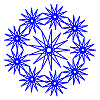Decimal Point
DECIMAL POINT
"Number is plurality or combination of units" (Aristotle).
"Number is the exponent of an operation" (Wittgenstein,
Tractatus 6.021).
Semantics
Converting a composite number to a simple number (simple sequence of digits). A composite number is a sequence of numbers, which in turn, can contain numbers.
Syntax
The "decimal point" (.) is used in three possible ways:
Decimal point to the right (postfix): x.
Left decimal point (prefix): .y
Middle decimal point (infix): x.y
Definition
⟨( x . =: (x ← (x # = 1) →' (x \(x #))). +
x \[1…((x #)−1)]).) )⟩ // (recursive definition)
(13 5 71 4). = 4 + (13 5 71).*10
⟨( .y =: (y . ÷ 10^(y #)) )⟩
.1234 = 1234. ÷ 10^4
⟨( x .y =: (x . + .y ) )⟩
1234.5678 = 1234. + .5678
Examples
(7 12 4). // ev. (7*(10^2) + 12*10 + 4) ev. 824
(42 57). // ev. (42*10 + 57) ev. 477
(7 (12 13) 4). // ev. (7*100 + (12 13).*10 + 4) ev. (7*100 + (12*10 + 13)*10 + 4) ev. 2034.
(1 −23 4). // ev. (100 − 230 + 4) ev. −126
.(4 (5 6) 3) // ev. .(400 + 560 + 3) ev. .963
(3 .4 5). // ev. (300 + 4 + 5) ev. 309
.(3 .4 5) // ev. .(300 + 4 + 5) ev. .309
.(3 .41 5) // ev. .(300 + 4.1 + 5) ev. .(309.1) ev. .3091
(12 13).(1 4 15) // ev. 12*10 + 13 + 1*10−1 * 4*10−2 + 15*10−3 ev. 133.155
123. // self-evaluates
.123 // self-evaluates
123.456 // self-evaluates
Remarks
The definition of "decimal point" uses potential substitution (representation), but it could be defined as immediate substitution.
A simple sequence of digits is interpreted as a sequence or as a number, depending on the context, that is, on the type of operation that affects it. This is the only case of polymorphism admitted in MENTAL, justified by the greater ease of use [see MENTAL Language - Principles - Polymorphism]. For example,
(123 ∪ 456) // ev. 123456 (interpreted as sequences)
A particular case of composite number is that of a sequence formed by digits (each with positive or negative sign). Examples:
(3 −4 −5). // ev. (300 −40 − 5) ev. 255
45 and .345
Flexible representation of numbers
Since a number can be composed of other numbers, a flexible representation system is available, allowing a number to be represented in multiple ways.
For example, the number
17 can be represented as:
17 (2 −3). (3 −13). (4 −23). (1.7 0). (1.6 1). (1.5 2). (1.44 2.6). (1.92 −2.2). etc.
Analogously, the number
.17 can be represented as:
.17 .(2 −3) .(3 −13) .(4 −23) .(1.7 0) .(1.6 1) .(1.5 2) .(1.44 2.6) .(1.92 −2.2) etc.
Normalization of a number
A number is said to be in normalized format when:
The sequence is composed of digits only.
There is only one sign for the entire sequence.
To switch to normalized format, the operator "
." (decimal point) is applied. Examples:
(x = (1.44 2.8))
((x = 13) (y = 122))
(x = 12)
Variable number
It is a sequence (hierarchical or not) variables may appear. When those variables have concrete values, the sequence is evaluated as a concrete normalized number. Examples:
(2 x 1). // rep. (2*100 + x + 1) ev. 201+x
(x = ab1)
(x = (a (b c)).
Properties
⟨( (m . = m ) )⟩
123. // ev. 123
⟨( .(x .) = .x )⟩
⟨( x .. = x . )⟩ // additional dots on the right have no effect
⟨( ..x ≡ (.x ÷ 10) )⟩
(..123 ≡ .0123)
⟨( x .θ = x . )⟩
⟨( θ.x = .x )⟩
⟨( x .0 = x )⟩
⟨( 0.x = .x )⟩
⟨( (−x ).y = (−x + .y ) )⟩
⟨( x .(−y ) = (x − .y ) )⟩
⟨( (−x ).(−y ) = (−x + . −y ) = −(x .y ) = −x .y ) )⟩
⟨( ((x y ). + (z u )).) ≡ ((x +z ). (y +u ).). )⟩
((5 4). + (8 9).) // ev. 54 + 89 ev. 143
⟨((x y ). * (z ).)) ≡ ((x . * z .) (y . * z .)).⟩ // product distribution
((5 4). * 3) // ev. 54*3 ev. 162
⟨( −(x y ). ≡(−x −y ). )⟩ // sign distribution
−(7 6). // eq. (−7 −6). ev. −76
⟨( (x .y − .y ) = x . )⟩
⟨( (x .y − x .) = .y )⟩
